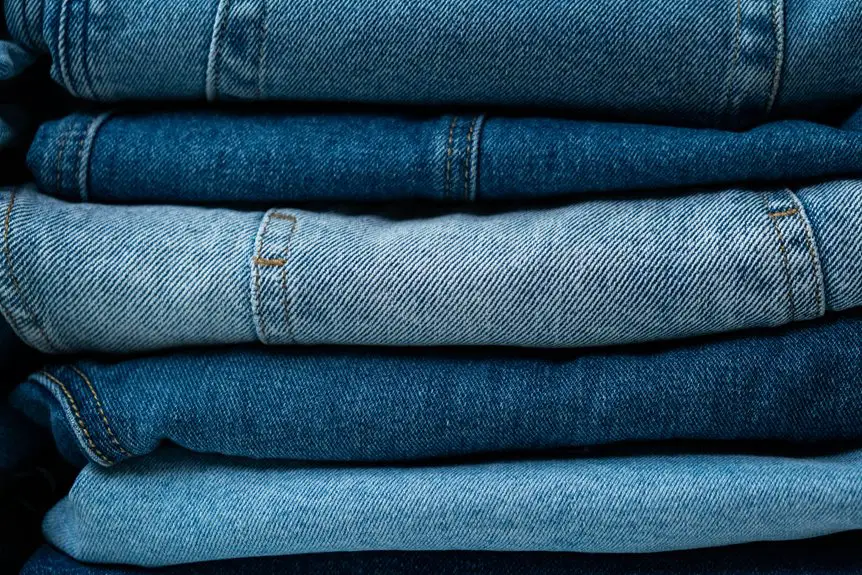To set the dye in your new jeans and prevent bleeding, soak them in a solution of one cup of white vinegar and cold water for about 30 minutes. This helps lock in the color. After soaking, rinse your jeans in cold water and air dry them away from sunlight. Additionally, make sure to wash them inside out, use cold water, and avoid mixing with lighter colors. There’s more great advice on maintaining their color.
Table of Contents
Key Takeaways
- Soak new jeans in a vinegar solution (one cup of white vinegar in cold water) for 30 minutes to help lock in color.
- Rinse the jeans in cold water after soaking to remove excess vinegar and dye.
- Turn jeans inside out before washing to minimize friction and protect the outer fabric.
- Limit washing frequency and spot clean stains to prevent unnecessary dye loss.
- Air dry jeans away from direct sunlight to maintain color vibrancy and prevent fading.
Understanding Denim Quality and Its Impact on Dye Bleeding
When you buy new jeans, understanding denim quality is essential because it directly affects dye bleeding. High-quality denim typically undergoes better dyeing processes, which means the colors are more likely to stay vibrant.
Look for jeans made from 100% cotton or a cotton blend with minimal synthetic fibers. These fabrics usually hold dye more effectively. Additionally, check the weight of the denim; heavier fabrics often have a tighter weave, reducing the likelihood of dye transfer.
Inspect the stitching and finishing details as well; well-constructed jeans tend to resist wear and fading. By choosing quality denim, you’ll not only enjoy a better fit and feel but also minimize the risk of dye bleeding onto your skin or other clothing items.
Effective Washing Techniques for New Jeans
To keep your new jeans looking fresh and to prevent dye bleeding, it’s crucial to adopt effective washing techniques.
Start by turning your jeans inside out; this protects the outer fabric during the wash. Use cold water, as it helps preserve color and prevent shrinkage. Opt for a gentle cycle on your washing machine to minimize wear and tear.
Turning your jeans inside out, using cold water, and selecting a gentle cycle can significantly extend their lifespan and maintain their color.
Avoid using bleach or harsh detergents, as these can strip the dye. Instead, choose a mild detergent designed for dark fabrics.
After washing, air dry your jeans rather than using a dryer, which can cause fading.
Finally, wash your jeans separately or with similar colors to avoid any unwanted dye transfer. These simple steps will help maintain your jeans’ vibrant appearance.
Strategies for Preventing Dye Transfer
After washing your new jeans with care, it’s important to take further steps to prevent dye transfer.
Here are some effective strategies you can use:
- Always wash with similar colors: Keep your jeans away from light-colored fabrics to minimize the risk of color bleeding.
- Use cold water: Cold water helps to set the dye and keeps it from loosening and transferring to other fabrics.
- Turn your jeans inside out: This protects the outer layer, reducing friction during the wash that can lead to fading and bleeding.
Methods for Setting the Dye in Denim
To set the dye in your new jeans, you can try a couple of effective methods.
The vinegar washing technique helps lock in color, while dye fixatives offer an extra layer of protection.
Let’s explore how each of these methods works to keep your denim looking fresh.
Vinegar Washing Technique
While you might be excited to wear your new jeans, it’s essential to set the dye properly to prevent fading. One effective method is the vinegar washing technique. This simple process helps lock in the color and minimize bleeding.
Here’s how to do it:
- Prepare a solution: Mix one cup of white vinegar with cold water in your washing machine or a large basin.
- Soak your jeans: Submerge the jeans in the vinegar solution for about 30 minutes to allow the fabric to absorb the vinegar.
- Rinse and dry: After soaking, rinse the jeans in cold water and air dry them away from direct sunlight.
Using this technique can help keep your jeans looking vibrant for longer, so give it a try!
Dye Fixatives Application
Setting the dye in your new jeans can be a game-changer for maintaining their color.
One effective method is to use a commercial dye fixative, which you can find at craft or fabric stores. Start by washing your jeans in cold water to remove any excess dye.
After that, mix the fixative according to the package instructions, usually in a bucket or basin. Submerge your jeans in the solution for the recommended time, often around 30 minutes.
Rinse them thoroughly in cold water afterward. Hang them to dry away from direct sunlight to prevent fading.
This simple application can greatly reduce bleeding and keep your denim looking vibrant longer. Enjoy your fresh, long-lasting jeans!
Proper Care for New Jeans to Preserve Color
To keep your new jeans looking vibrant, you need to follow the right washing techniques. Knowing how to wash and dry them properly will help preserve their color and prevent fading.
Let’s explore the best practices for washing and drying your denim.
Washing Techniques Overview
When you bring home new jeans, you’ll want to take care of them to maintain their vibrant color. Proper washing techniques are essential in preventing dye bleeding.
Start by turning your jeans inside out to protect the outer fabric. Use cold water, as it helps set the dye and reduces color loss. Avoid bleach and harsh detergents that can strip away color.
- Wash with similar colors to prevent dye transfer.
- Limit washing frequency; spot clean when possible.
- Choose a gentle cycle to minimize agitation.
Drying Methods Explained
Although drying your new jeans may seem straightforward, the method you choose can greatly impact their color and overall longevity.
Air drying is your best bet; just hang them inside or outside, away from direct sunlight, to prevent fading. If you prefer using a dryer, opt for a low heat setting to minimize damage.
Remember to turn your jeans inside out before drying, as this helps shield the fabric from harsh conditions. Whatever method you choose, avoid wringing or twisting your jeans, which can distort their shape.
Finally, always check the care label for specific instructions, as following these guidelines will help preserve your jeans’ vibrant color and guarantee they last for years to come.
Common Issues With Dye Bleeding and Their Solutions
Dye bleeding is a common issue that can ruin your favorite new jeans, but understanding its causes can help you prevent it.
Here are some common problems you might encounter and their solutions:
- Washing with other clothes: Always wash your jeans separately, especially the first few times, to avoid dye transfer.
- Using hot water: Stick to cold water when washing your jeans; hot water can cause the dye to loosen and bleed.
- Improper drying: Avoid direct sunlight when drying your jeans, as it can fade the color and promote bleeding.
Frequently Asked Questions
Can I Use Fabric Softener With New Jeans?
Did you know that over 80% of people use fabric softener? While you can use it with new jeans, it might reduce their durability and affect their fit. Consider skipping it for longer-lasting wear.
How Long Should I Wait Before Washing New Jeans?
You should wait at least a week before washing new jeans. This allows the dye to set properly. When you do wash them, use cold water to help prevent fading and bleeding.
Will Soaking Jeans in Vinegar Help?
You might wonder if soaking jeans in vinegar really works. Surprisingly, it can help set the dye, but results vary. Experiment cautiously and see if it reduces bleeding, but don’t expect miracles every time.
Can I Wash Jeans With Other Colors?
You shouldn’t wash new jeans with other colors. They often bleed, especially in the first few washes. To keep your clothes looking fresh, wash them separately until you’re sure they won’t fade.
What Temperature Should the Water Be for Washing Jeans?
When washing your wonderful jeans, warm water works wonders. Aim for temperatures around 30 to 40 degrees Celsius. This balance helps maintain color and fabric integrity, ensuring your stylish pants stay looking sharp and superb.
- Recycling Nonwoven Fabrics: Is It Possible? - July 11, 2025
- Recycling Nonwoven Fabrics: Is It Possible? - July 11, 2025
- Recycling Nonwoven Fabrics: Is It Possible? - July 11, 2025







